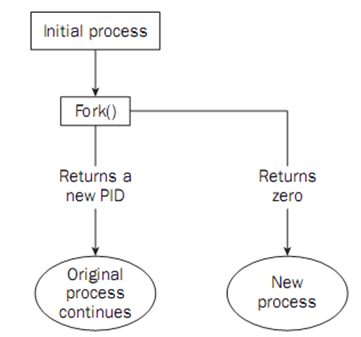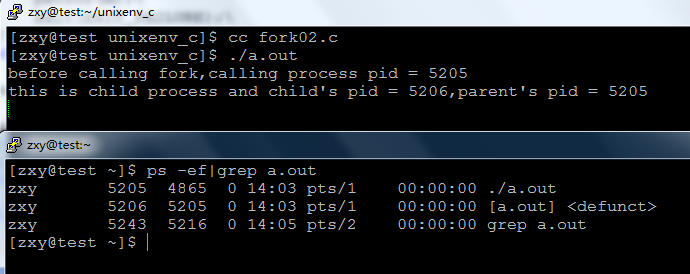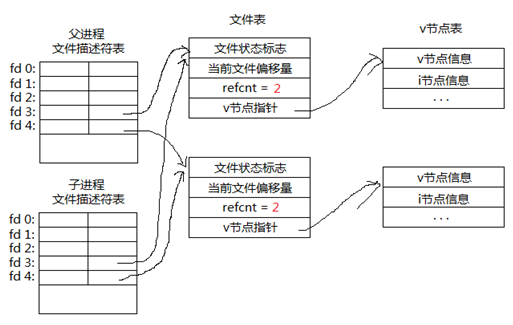本节目标:
- 复制进程映像
- fork系统调用
- 孤儿进程、僵尸进程
- 写时复制
一,进程复制(或产生)
使用fork函数得到的子进程从父进程的继承了整个进程的地址空间,包括:进程上下文、进程堆栈、内存信息、打开的文件描述符、信号控制设置、进程优先级、进程组号、当前工作目录、根目录、资源限制、控制终端等。
子进程与父进程的区别在于:
1、父进程设置的锁,子进程不继承(因为如果是排它锁,被继承的话,矛盾了)
2、各自的进程ID和父进程ID不同
3、子进程的未决告警被清除;
4、子进程的未决信号集设置为空集。
二,fork系统调用
包含头文件 <sys/types.h> 和 <unistd.h>
函数功能:创建一个子进程
函数原型
pid_t fork(void); //一次调用两次返回值,是在各自的地址空间返回,意味着现在有两个基本一样的进程在执行
参数:无参数。
返回值:
- 如果成功创建一个子进程,对于父进程来说返回子进程ID
- 如果成功创建一个子进程,对于子进程来说返回值为0
- 如果为-1表示创建失败
流程图:
父进程调用fork()系统调用,然后陷入内核,进行进程复制,如果成功:
1,则对调用进程即父进程来说返回值为刚产生的子进程pid,因为进程PCB没有子进程信息,父进程只能通过这样获得。
2,对子进程(刚产生的新进程),则返回0,
这时就有两个进程在接着向下执行
如果失败,则返回0,调用进程继续向下执行
注:fork英文意思:分支,fork系统调用复制产生的子进程与父进程(调用进程)基本一样:代码段+数据段+堆栈段+PCB,当前的运行环境基本一样,所以子进程在fork之后开始向下执行,而不会从头开始执行。
示例程序:
#include <stdio.h> #include <unistd.h> #include <stdlib.h> #define ERR_EXIT(m) do { perror(m); exit(EXIT_FAILURE); } while (0) int main(void) { pid_t pid; printf("before calling fork,calling process pid = %d ",getpid()); pid = fork(); if(pid == -1) ERR_EXIT("fork error"); if(pid == 0){ printf("this is child process and child's pid = %d,parent's pid = %d ",getpid(),getppid()); } if(pid > 0){ //sleep(1); printf("this is parent process and pid =%d ,child's pid = %d ",getpid(),pid); } return 0; }
运行结果:
当没给父进程没加sleep时,由于父进程先执行完,子进程成了孤儿进程,系统将其托孤给了1(init)进程,
所以ppid =1。
当加上sleep后,子进程先执行完:
这次可以正确看到想要的结果。
三,孤儿进程、僵尸进程
fork系统调用之后,父子进程将交替执行,执行顺序不定。
如果父进程先退出,子进程还没退出那么子进程的父进程将变为init进程(托孤给了init进程)。(注:任何一个进程都必须有父进程)
如果子进程先退出,父进程还没退出,那么子进程必须等到父进程捕获到了子进程的退出状态才真正结束,否则这个时候子进程就成为僵进程(僵尸进程:只保留一些退出信息供父进程查询)
示例:
#include <stdio.h> #include <unistd.h> #include <stdlib.h> #define ERR_EXIT(m) do { perror(m); exit(EXIT_FAILURE); } while (0) int main(void) { pid_t pid; printf("before calling fork,calling process pid = %d ",getpid()); pid = fork(); if(pid == -1) ERR_EXIT("fork error"); if(pid == 0){ printf("this is child process and child's pid = %d,parent's pid = %d ",getpid(),getppid()); } if(pid > 0){ sleep(100); printf("this is parent process and pid =%d ,child's pid = %d ",getpid(),pid); } return 0; }
以上程序跟前面那个基本一致,就是让父进程睡眠100秒,好让子进程先退出
运行结果:
从上可以看到,子进程先退出,但进程列表中还可以查看到子进程,[a.out] <defunct>,死的意思,即僵尸进程,如果系统中存在过多的僵尸进程,将会使得新的进程不能产生。
四,写时复制
linux系统为了提高系统性能和资源利用率,在fork出一个新进程时,系统并没有真正复制一个副本。
如果多个进程要读取它们自己的那部分资源的副本,那么复制是不必要的。
每个进程只要保存一个指向这个资源的指针就可以了。
如果一个进程要修改自己的那份资源的“副本”,那么就会复制那份资源。这就是写时复制的含义
fork 和vfork:
在fork还没实现copy on write之前。Unix设计者很关心fork之后立刻执行exec所造成的地址空间浪费,所以引入了vfork系统调用。
vfork有个限制,子进程必须立刻执行_exit或者exec函数。
即使fork实现了copy on write,效率也没有vfork高,但是我们不推荐使用vfork,因为几乎每一个vfork的实现,都或多或少存在一定的问题
vfork:
Linux Description
vfork(), just like fork(2), creates a child process of the calling pro-
cess. For details and return value and errors, see fork(2).
vfork() is a special case of clone(2). It is used to create new pro-
cesses without copying the page tables of the parent process. It may
be useful in performance-sensitive applications where a child will be
created which then immediately issues an execve(2).
vfork() differs from fork(2) in that the parent is suspended until the
child terminates (either normally, by calling _exit(2), or abnormally,
after delivery of a fatal signal), or it makes a call to execve(2).
Until that point, the child shares all memory with its parent, includ-
ing the stack. The child must not return from the current function or
call exit(3), but may call _exit(2).
Signal handlers are inherited, but not shared. Signals to the parent
arrive after the child releases the parent’s memory (i.e., after the
child terminates or calls execve(2)).
示例程序:
#include <stdio.h> #include <unistd.h> #include <stdlib.h> #define ERR_EXIT(m) do { perror(m); exit(EXIT_FAILURE); } while (0) int main(void) { pid_t pid; int val = 1; printf("before calling fork, val = %d ",val); //pid = fork(); pid = vfork(); if(pid == -1) ERR_EXIT("fork error"); if(pid == 0){ printf("chile process,before change val, val = %d ",val); val++; //sleep(1); printf("this is child process and val = %d ",val); _exit(0); } if(pid > 0){ sleep(1); //val++; printf("this is parent process and val = %d ",val); } return 0; }
当调用fork时:
运行结果:
可知写时复制
当使用vfork但子进程没使用exit退出时:
结果出错了,
使用vfork且exit退出:
结果正常,父子进程共享
fork之后父子进程共享文件:
fork产生的子进程与父进程相同的文件文件描述符指向相同的文件表,引用计数增加,共享文件文件偏移指针
示例程序:
#include <stdio.h> #include <unistd.h> #include <stdlib.h> #include <fcntl.h> #define ERR_EXIT(m) do { perror(m); exit(EXIT_FAILURE); } while (0) int main(void) { pid_t pid; int fd; fd = open("test.txt",O_WRONLY); if(fd == -1) ERR_EXIT("OPEN ERROR"); pid = fork(); if(pid == -1) ERR_EXIT("fork error"); if(pid == 0){ write(fd,"child",5); } if(pid > 0){ //sleep(1); write(fd,"parent",6); } return 0; }
运行结果:
可知父子进程共享文件偏移指针,父进程写完后文件偏移到parent后子进程开始接着写。








